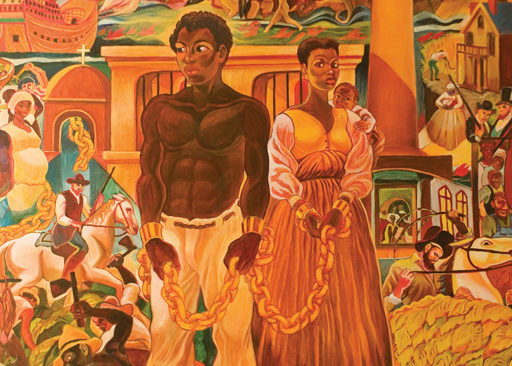Ropes and chains and the piercing masts of slave ships at harbor pop up as boldly as the brilliant colors that command Arvie Smith‘s paintings in the exhibition “At Freedom’s Door.” Smith’s big oils of slave auctions and lynchings and other aspects of the bleak side of antebellum life are like jam-packed chapters in a vast historical novel bursting to be told. Some of his more satiric images are reminiscent of Robert Colescott, and his brown-yellow-red palette brings to mind some of the color combinations of fellow Portland artist Isaka Shamsud-din. But in their narrative urgency, their invocation of historical moment and their sometimes quizzical snatches of story (you get the feeling that you’ve been dropped into the middle of something, but you’re not quite sure where it started, although you have a good idea where it’s likely to end) Smith’s paintings also have a novelist’s sense: They make me think of Charles Johnson and his great American slave story of the beginnings of things, “Middle Passage.”

“At Freedom’s Door,” which also includes fabric art by Baltimorean Joan Gaither and the admirable Portland artist Adriene Cruz, was originally shown last year at Baltimore’s Reginald F. Lewis Museum, where Smith and Gaither were artists in residence. Now in the Feldman Gallery of Pacific Northwest College of Art through March 8, it’s one of a pair of provocative exhibits in Portland noncommercial galleries that commemorate Black History Month. The other, on view through March 2 at Reed College’s Cooley Gallery, is “Working History”, which features work by such nationally notable artists as Kara Walker, Io Palmer, Faith Ringgold, Kianga Ford, David Hammons and Nick Cave.
The combination of these three artists in “At Freedom’s Door” plays a nice ping-pong in your head, knocking you back and forth among varying aspects of the African American experience. And they represent three intriguingly different artistic sensibilities.
Continue reading “At Freedom’s Door”: Novels in paint, provocations in fabric